
Digital painting by André Trenier, 2022, provided courtesy New York Botanical Garden
.
If you have any comments, observations, or questions about what you read here, remember you can always Contact Me
All content included on this site such as text, graphics and images is protected by U.S and international copyright law.
The compilation of all content on this site is the exclusive property of the site copyright holder.
Around the Table: Stories of the Foods We Love
at the New York Botanical Garden:
African American Garden: Remembrance & Resilience
Wednesday, 1 June 2022
Today is the media preview for the New York Botanical Garden's grand summer event, Around the Table: Stories of the Foods We Love. Opening to the public this Saturday, 4 June, it is a garden-wide presentation celebrating plants as the foundation of all culinary customs.

Digital painting by André Trenier, 2022, provided courtesy New York Botanical Garden
There's too much for me to cram into a single entry.
I'll take a more focused view with several stories.
There is so much to see! Our preview group starts in the Enid Haupt Conservatory's palm court, wanders outdoors to the display around the hardy water lily pool, back into the conservatory to the exhibition wing, then outdoors to the conservatory lawn.

And finish with a tram ride to the Edible Academy, a 3 acre, state of the art children and family learning facility about growing and using produce. (It is about a mile from the conservatory. )
While certainly appropriate, we're actually here for

the African American Garden which is just across way.
The press release makes mention that: "In the multiple planting beds of the African American Garden, visitors will find stories of resilience and resistance, remembrance and rebirth told through the plants of our world. From rice, okra, and other grains and greens to cotton and indigo, watercress, and licorice root, each bed features groups of essential plants grown and foraged for food, dyeing and cloth making, healing, and more. Evoking the kinds of plants free and enslaved Blacks would have kept, the African American Garden pays homage to the ancestral knowledge passed down through generations of families and communities. Interpretive signage provides historical context, tracing the roots of plants brought to America via the transatlantic slave trade, how they were cultivated and prepared primarily in the American South, and how they found their way onto tables everywhere."

Photo by Ben Hider, courtesy The New York Botanical Garden
There are eight planting beds, each with a different collection of plants,
some are certainly familiar to everyone, and others much less well known.
The signage for this exhibition is superb.

They explain the histories, traditions, uses, adaptations.
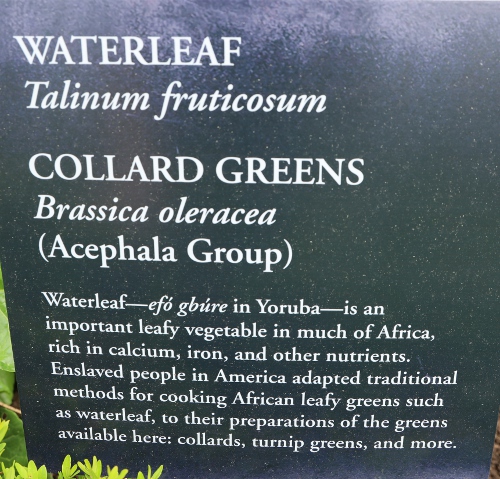
Plants are named, including their cultivar like these collards,
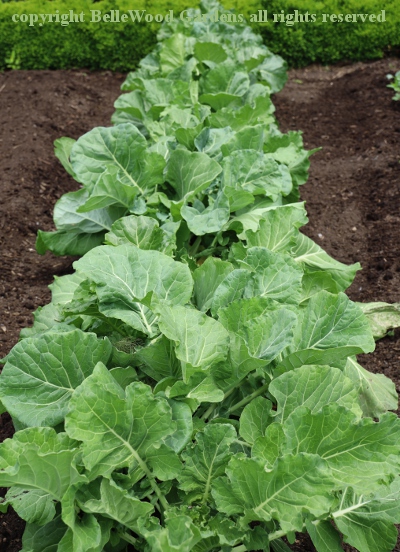
Brassica oleracea 'Green Glaze'. And if you want to grow some for yourself,
The Shop has seeds from specialty vendors such as TrueLove Seeds,
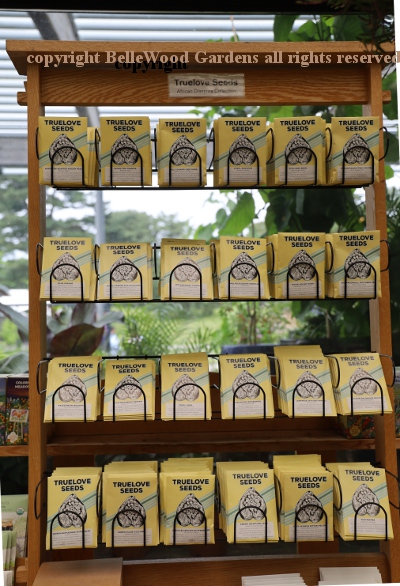
with their seeds of vegetables from the African diaspora.
There is a Poetry Walk along the tall hedge, with six poems by African American poets

such as this oh so appropriate one about cutting greens.

There is an orientation center, shaded seating areas, and a Hibiscus Drink Station,

Not the ornamental hibiscus you might grow in your summer garden. It is
an infusion from deep crimson calyces of the roselle, Hibiscus sabdariffa,
and other refreshing ingredients. You may have had it as a hot hibiscus tea.
The first bed, In the Beginning, has four different cultivars of cotton, indigo as a dye plant, rice, sesame, sugarcane, and tobacco. The second bed has several collard cultivars, a couple of kinds of kale and also mustard greens, and a leafy turnip.
Grains are the focus of the third bed. Corn is familiar to us all, though mostly as sweet corn. Any flint corn, suitable for milling into cornmeal, would likely be bought already ground. Field peas may not sound familiar but you've probably heard of black eyed peas, to be eaten on New Year's day, for luck. Millet. And sorghum. This early in the growing season the young plants look much like corn. But when they produce their seeds the difference is obvious.
Where I live in western New Jersey I do see sorghum growing as a field crop.

Not around here, but it is possible to harvest the canes, next strip off leaves
and seed heads. Then crush, press, skim, and boil to make sorghum syrup.
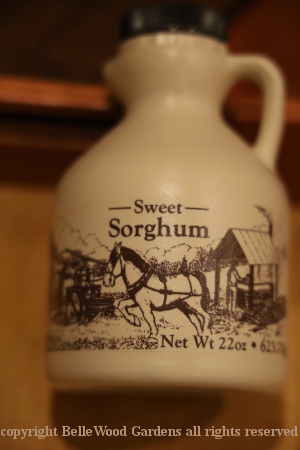
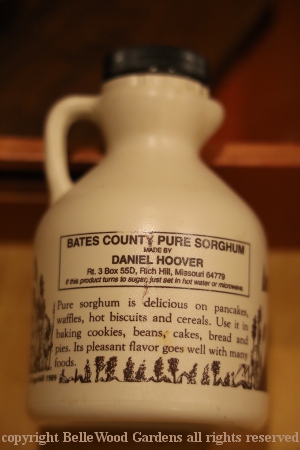
The fourth bed, the Cookpot, has many of everyone's favorites: eggplant and tomatoes, onions, yam, peppers. And okra.
Plants used for Making & Mending are in the 5th bed - again cotton
and indigo, and also flax and kenaf, saw palmetto, and sweetgrass.
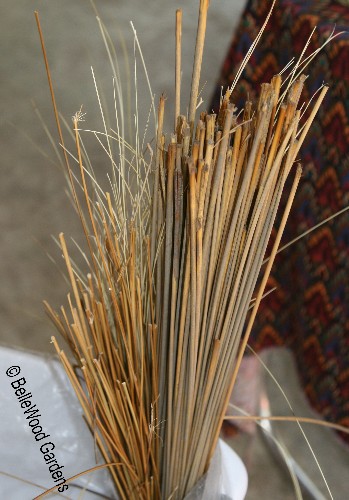
Sweetgrass, in Charleston, where baskets more decorative than practical

are made for the tourist trade. Did you know that baskets can only be made by hand?
Foraging, plants found Out in the Wild for food are in the 6th bed. Strawberries, raspberries, blueberries, elderberries. Sunchokes. Dandelion - probably roots as well as greens. And more. Then in Bed 7 are plants for Curing & Conjuring. Again collards and okra, catnip, aloe, ginger, birdhouse gourd, licorice root, sage, watermelon, and roselle, the Hibiscus sabdariffa, that is the primary ingredient of the red drink. Which, the woman offering very welcome samples of roselle red drink (your choice of sweetened or unsweetened) told us is useful as a diuretic, also for high blood pressure, and more.
The eighth and last bed is perhaps the most evocative, focusing as it does on Remembrance & Resilience. Collards, which seem to have endless associations. Groundnut, in Africa, which was replaced with peanuts in America. Several different efo shoka, from Lagos spinach, eggplant leaf, waterleaf. Four different cultivars of field peas. Sweet potatoes and yams, which are not the same (regardless of what you might see in the supermarket!)
I need to return sometime in the summer when the plants have made more growth. And include a visit to the Library, where there is a display of that I never even got to, this time around. But clearly there will be an opportunity, as Around the Table: Stories of the Foods We Love is on view from 4 June through 11 September, 2022. Do come visit, at least once if not more. You'll be glad you did!
Back to Top
Back to June
Back to the main Diary Page